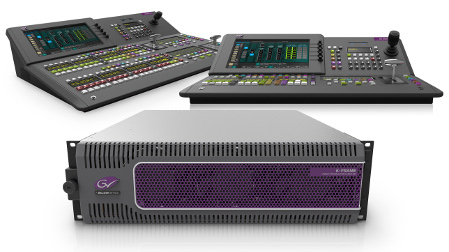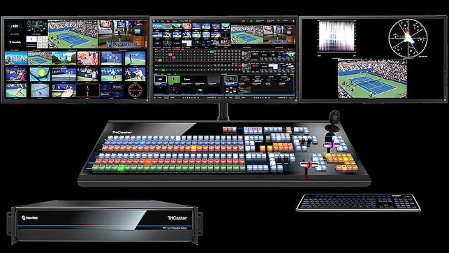Production Switchers Pack on the Features
ALEXANDRIA, VA.—Before inexpensive processors and memory revolutionized how video is shot, recorded and edited, production switchers had a rigidly limited scope: All they did was switch and key images. You could select among video sources, do simple effects (such as wipes and dissolves) between them, and you could key in a title or perform a chroma key—that was pretty much it.

Grass Valley Korona K-Frame V-series production switcher
In todayʼs digital era, production switchers are far more complex and capable. Not only does a modern switcher do everything the old ones did, current models store and recall graphics and video clips, control external devices such as cameras and recorders, as well as perform complex real-time 3D effects unimagined in the analog era.
Can this trend continue? For one thing, production switchers are operated in real time by real people under a lot of pressure to be accurate and error-free. Is there a danger that these operators will be overloaded by the switchersʼ growing capabilities?
“Every time we think we have maxed out our operators, we are proven wrong,ˮ said Greg Huttie, vice president for production switchers at Grass Valley. “We ask our users from all segments of TV production what they find hard and what they find easy so we can address those functions more effectively to either simplify processes or expand on the opportunities.ˮ
MAKING IT SIMPLE
Making the difficult simple for the user is apparently the credo of production switcher manufacturers.
The professional video industry's #1 source for news, trends and product and tech information. Sign up below.
“As long as the equipment used is intuitive and allows technical directors and operators to simplify their workflow, it is possible to add a number of features and capabilities into switchers,ˮ said John Carter, senior product manager for Snell Advanced Media (SAM). “This enhanced capability is in addition to features like pre-sets, such as effects or macros. Adding more functionality in the future doesn’t add problems for operators and broadcasters because there is always the option to program this into a switcher as required. We will see more features built into production switchers, and this is a positive step promoting constant development and fresh product improvements.ˮ
In addition to being at the heart of most live video production operations and the connectivity to video devices that requires, production switchers now all have IP connectivity, which brings yet additional network capability to switchers.
One example of this is Broadcast Pixʼs switchers and the companyʼs BPNet, an IP-based system that can be used to transfer visual material (stills and video clips) as well as control other devices.
“A lot of times the workflow doesn’t work because systems from different manufacturers don’t communicate well,ˮ said Tony Mastantuono, product manager for Broadcast Pix in Chelmsford, Mass. “BPNet is our IP-based ecosystem that lets you manage clips, graphics, data and other assets securely through the cloud using a Web browser. BPNet handles all the transcoding automatically, so it eliminates all the formatting and FTP issues that get in the way of your creativity.”
REACHED THE LIMIT?
So have we reached the limit of what we can expect an operator to handle when sitting at a switcher control panel for a demanding production?

NewTek TriCaster TC1 streaming switcher
“The more tools we can bundle into one of our systems benefits everyone and simplifies workflows,ˮ Mastantuono said. “I don’t think we’ve reached the limit to what we can integrate into our integrated production switchers—after all, customers keep asking us for more. For example, motion graphics have traditionally required a dedicated system. We’ve included NewBlueFX, a multi-layer 3D motion graphics CG, with our BPswitch integrated production switchers.ˮ
Many broadcasters have newsroom automation systems that include switchers that allow management of cameras, all controlled with a button push from the technical director sitting at the production switcher. One button press will move a camera into position for the chroma-keyed weather report, including movement of the camera pedestal as well as pan, tilt, zoom and focus. Ross Video is one of several switcher companies that specializes in complete news studio systems that include this sort of capability.
Of course, today a “broadcasterˮ can be an organization that streams video via the Web. NewTek has carved out a niche as a provider of production switchers that excel at Web streaming. Brian Olson, vice president of product management for the San Antonio-based company, said that webcasters and broadcasters want the same thing in their productions.
“Streaming is just a change in the way content is delivered, not necessarily a change to the way video is produced,ˮ Olson said. “That said, streaming has opened up video production to a broader range of users who sometimes have less sophisticated productions and use a smaller subset of functionality. Online game streamers have tapped into the APIs of the streaming platforms to pull data and display it on-screen. That is one specific instance where streaming uses different features. NewTekʼs NDI has also made it really easy to pull the desktops from gaming computers and game consoles to make them available as video sources for a streaming production.ˮ
4K, UHD & HDR
Switcher vendors are delivering systems for 4K production, and some even have models for UHD high dynamic range production. Carter noted that SAM’s Kahuna switcher has seen a dramatic uptake, with live deployments by remote/OB companies worldwide due to the way it switches and produces UHD, all while simultaneously producing HD.
“UHD sports productions, such as Formula 1and the English Premier League are produced weekly using Kahuna, with technical directors repeatedly telling us that it is just like switching HD,” Carter said. “The next stage beyond UHD is HDR, which delivers an even richer viewing experience. Kahuna now can ship with FormatFusion4, which has the added benefit of switching in HDR and wide color gamut in either UHD or 1080p.ˮ
Most product categories in this industry have evolved with new products doing things that could not have been imagined 30 years ago, and production switchers may be leading the pack in that regard. If the prospect of getting a new switcher that has an ever-growing list of capabilities is a little daunting, consider that switchers today generally cost less than they did a couple decades ago.
Getting more for your money has to be a good thing.
Bob Kovacs is the former Technology Editor for TV Tech and editor of Government Video. He is a long-time video engineer and writer, who now works as a video producer for a government agency. In 2020, Kovacs won several awards as the editor and co-producer of the short film "Rendezvous."

